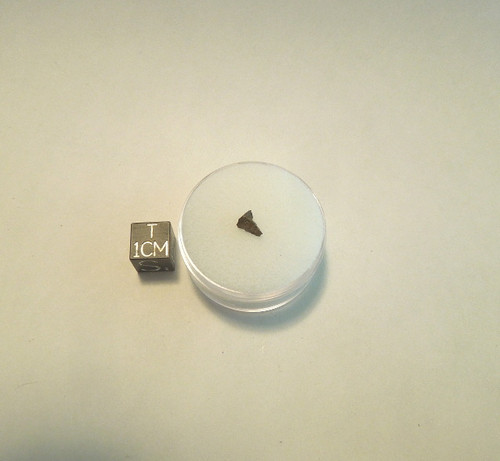This is an exciting and interesting meteorite. It represents something you only see on rare occasion in the world of meteorites - a new classification type. This is a new subtype of the CV group and it represents a reduced version of these meteorites. CV-red meteorites have undergone extensive aqueous alteration prior to their time on Earth. This oxidation and reduction is not the product of terrestrial weathering. At some point in their ancient history, these meteorites were altered by water.
NWA 13385 was first recovered out of the Saharan Desert of Morocco in 2015 and due to it's unusual nature, the classification process was long and intensive to figure out exactly where this meteorite fit into the other types. It was officially classified as the very first CV-red-3 type. As is typical of most CV3 types, it is loaded with chondrules.
Refer to the photo. The black centimeter cube is shown for scale and is not included. You are purchasing a single small fragment like the one shown. Your purchase will include an ID label and gemjar for safe storage.
From the Meteoritical Bulletin entry on NWA 13385 :
Northwest Africa 13385 (NWA 13385)
Drâa-Tafilalet, Morocco
Purchased: 2015
Classification: CVred3
History: Mohamed Boukbot found the samples in the desert 3.8 km NE of the town of Mezguida, Drâa-Tafilalet, Morocco. Many samples were distributed to a number of dealers and subsequently purchased by John Higgins in 2015.
Physical characteristics: Type specimens are dark-light brown and have an irregular-shaped exterior. The cut face shows the interior is composed of abundant chondrules and refractory inclusions. The color variation of the interior of some stones show regions stained by FeOH minerals indicating variable weathering.
Petrography: Description and classification (A. Love, App): Sample shows brecciated chondritic texture composed of distinct chondrules with an average diameter of 640 μm (n=51), fragments, refractory inclusions (CAIs and AOAs) and a single xenolithic clast set within a fine-grained opaque oxidized matrix (~55 vol%). Some porphyritic chondrules contain rounded inclusions of FeNi metal. The 2 × 3mm lithic clast contains unequilibrated chondrules with an average diameter of 112 μm (n=10).
Geochemistry: (A. Love, App) Olivine Fa6.4±8.0 (Fa0.3-33.0, n=18); low-Ca pyroxene Fs1.2±0.4Wo1.8±1.4 (Fs0.7-2.2Wo0.8-2.8, n=12); high-Ca pyroxene Fs1.8Wo31.1 (n=1). Sulfides contain 0.31±0.24 wt% Ni, n=18.
Classification: Carbonaceous chondrite (CVred3). Chondrule diameter, modal abundance of matrix, and abundant CAIs indicate sample is CV3. Presence of FeNi metal in silicates, wt% Ni in sulfides and magnetic susceptibility indicate the sample belongs to the CVred group (Bonal et al., 2020, Gattacceca et al., 2020).
Specimens: John Higgins holds the main mass. Many slices and endcuts totaling 37.82 g and a polished thin section and mount are on deposit at App.





